History of The Nekoma State Bank
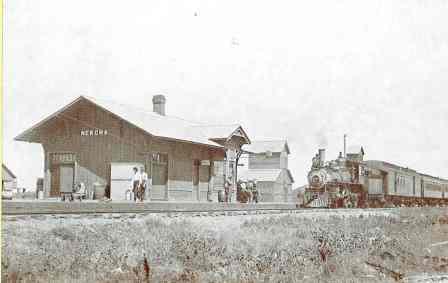 John W. Felch established Nekoma, Kansas when he homesteaded on the Walnut Creek between Rush Center and Alexander in 1871. A number of the original
settlers to area were Civil War veterans. The town experienced somewhat of a boom when the Chicago, Kansas & Western (formerly Walnut Valley & Colorado) Railroad, a subsidary of Atchison, Topeka, and Santa Fe railroad reached Nekoma on September 1, 1887 and a fine new depot was constructed. A post office was established in 1890. In 1893, Elmer Miller
built a general store and in 1900, Mike Moran built a large general store that included a large soda fountain and creamery. By 1900, the town had a population of 25. Over the next few years, the town had a blacksmith shop, three grain elevators, garages and gas stations, a cafe, barber shops, grocery stores, creamery, feed mill, rest home, and a bank.
The community also had a school, opera house, two churches, and a local chapter of the Independent Order of Oddfellows. The community's population peaked at just over 100 people near the turn of the century, but the town was never incorporated.
John W. Felch established Nekoma, Kansas when he homesteaded on the Walnut Creek between Rush Center and Alexander in 1871. A number of the original
settlers to area were Civil War veterans. The town experienced somewhat of a boom when the Chicago, Kansas & Western (formerly Walnut Valley & Colorado) Railroad, a subsidary of Atchison, Topeka, and Santa Fe railroad reached Nekoma on September 1, 1887 and a fine new depot was constructed. A post office was established in 1890. In 1893, Elmer Miller
built a general store and in 1900, Mike Moran built a large general store that included a large soda fountain and creamery. By 1900, the town had a population of 25. Over the next few years, the town had a blacksmith shop, three grain elevators, garages and gas stations, a cafe, barber shops, grocery stores, creamery, feed mill, rest home, and a bank.
The community also had a school, opera house, two churches, and a local chapter of the Independent Order of Oddfellows. The community's population peaked at just over 100 people near the turn of the century, but the town was never incorporated.
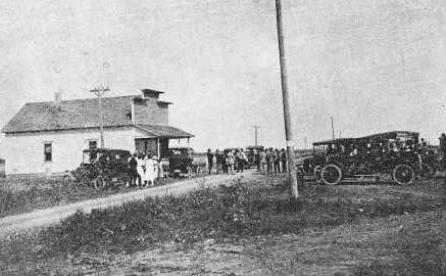 The State of Kansas chartered the bank on June 21, 1916. It opened for business on September 18 of that year with capital of $10,000. The original board of directors was composed of
A.H. Young, E.S. Chenoweth, A.E. Johnson, J.M. Mendenhall, A.U. Ream, G.M. Ryan, Thomas Ryan, James Seaman, and Michael T. Moran. Michael T. Moran was chairman of the board, James Seaman was president, and J.P. Moran was cashier.
The State of Kansas chartered the bank on June 21, 1916. It opened for business on September 18 of that year with capital of $10,000. The original board of directors was composed of
A.H. Young, E.S. Chenoweth, A.E. Johnson, J.M. Mendenhall, A.U. Ream, G.M. Ryan, Thomas Ryan, James Seaman, and Michael T. Moran. Michael T. Moran was chairman of the board, James Seaman was president, and J.P. Moran was cashier.
A new 24'x42' wood frame structure with a covered porch was constructed to house the bank. The building consisted of a main room finished with ornate woodwork, a brick-lined vault, and a storage room. Heat was provided by a pot-belly stove located next to the vault entrance.
The ribbon-cutting was an event to be remembered with a band concert, baseball game, and watermelon feed. People from all over the area came to Nekoma to join in the festivities. From the time of its opening, the bank was a hub of activity in the small community.
Not many changes were made to the building over the years. An addition to the building in 1961 added an office, a large mechanical and storage room, and an indoor restroom. Alterations were made to the front room including removal of metal "cages" on top of the Cashier and Teller windows, tile floors, and a suspended ceiling.
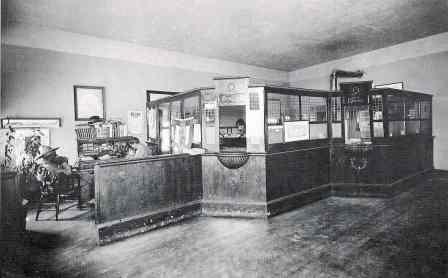 Surviving the Great Depression was not an easy task for rural banks. In 1932 and 1933, a large number of bank failures in the U.S. caused depositors to no longer trust banks with their money. In 1932 and 1933 almost half of U.S. banks closed.
Panic ensued and people began withdrawing large sums of money for fear of losing their meager savings to a bank failure. In an effort to forstall a national crisis, President Franklin Roosevelt declared a four-day bank holiday beginning March 4, 1933 proclaiming all banks to remain closed to allow time to come up with a plan to save struggling banks. For that week, many persons lived in fear
that their local bank would not open. The Emergency Bank Relief Act set strict guidelines and banks that passed examination were allowed to reopen. This action also led to passage a few months later of the Federal Banking Act of 1933 that established the Federal Deposit Insurance Corporation insuring accounts up to $5,000. The small bank in Nekoma,
Kansas weathered the storm and emerged from the depression years virtually unscathed.
Surviving the Great Depression was not an easy task for rural banks. In 1932 and 1933, a large number of bank failures in the U.S. caused depositors to no longer trust banks with their money. In 1932 and 1933 almost half of U.S. banks closed.
Panic ensued and people began withdrawing large sums of money for fear of losing their meager savings to a bank failure. In an effort to forstall a national crisis, President Franklin Roosevelt declared a four-day bank holiday beginning March 4, 1933 proclaiming all banks to remain closed to allow time to come up with a plan to save struggling banks. For that week, many persons lived in fear
that their local bank would not open. The Emergency Bank Relief Act set strict guidelines and banks that passed examination were allowed to reopen. This action also led to passage a few months later of the Federal Banking Act of 1933 that established the Federal Deposit Insurance Corporation insuring accounts up to $5,000. The small bank in Nekoma,
Kansas weathered the storm and emerged from the depression years virtually unscathed.
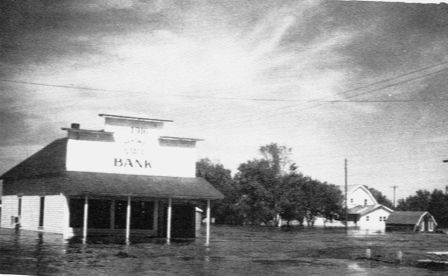 Floodwaters threatened Nekoma on at least two occasions. In 1902, the Walnut Creek went out of its banks and threatened the town when water reached the railroad grade. In 1959, predictions of another flood made many years prior came true.
The following is an excerpt from Rush County - 125 Years in Story and Pictures published by the Rush County Historical Society.
Floodwaters threatened Nekoma on at least two occasions. In 1902, the Walnut Creek went out of its banks and threatened the town when water reached the railroad grade. In 1959, predictions of another flood made many years prior came true.
The following is an excerpt from Rush County - 125 Years in Story and Pictures published by the Rush County Historical Society.
“On Sunday night, September 20, 1959, after almost twelve inches of rain, water five feet deep covered Nekoma. The houses in the west part of town were flooded on Sunday night and by Monday morning all of the houses contained water at varying depths. Melvin Phillips, Gilbert Seltman, and Charles Collins brought in boats. The men of the town worked all night to rescue people. Mrs. Bessie Maresch, owner of the Nekoma Rest Home, reported some of her ladies floating on mattresses. By noon Monday, boats had evacuated the entire town to the houses of people in the surrounding area without any casualties. It took many weeks to restore the buildings in Nekoma to habitable condition.”
To keep the bank in operation, furniture and records were moved across the railroad tracks outside of the deepest flood area to the home of Loretta Moran. There, business was resumed until flood water receeded and the bank building was cleaned and repaired.
According to the Rush County News “no building was spared” in the town of Nekoma. Floodwaters crested at the base of the windows of the bank building and today evidence of water damage is still visible on the interior of the building.
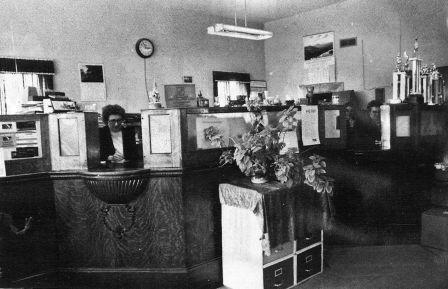 How did a cigar box foil an armed robbery? Friday, January 5th, 1979 started out just as any ordinary day. By late afternoon, bank employees Loretta Moran, Fern Ryan, and Joanne Phillips were balancing and closing out the business for the day.
At about 4:00, two men entered the bank. One was armed with a sawed off shotgun and the other was armed with a small handgun. The two men ordered the three women into the vault. Three additional robbers entered the bank, and the group removed money from the teller stations and the vault. The five escaped in a vehicle stolen earlier from the Rush County Livestock auction on the north edge of La Crosse.
How did a cigar box foil an armed robbery? Friday, January 5th, 1979 started out just as any ordinary day. By late afternoon, bank employees Loretta Moran, Fern Ryan, and Joanne Phillips were balancing and closing out the business for the day.
At about 4:00, two men entered the bank. One was armed with a sawed off shotgun and the other was armed with a small handgun. The two men ordered the three women into the vault. Three additional robbers entered the bank, and the group removed money from the teller stations and the vault. The five escaped in a vehicle stolen earlier from the Rush County Livestock auction on the north edge of La Crosse.
The robbers did not lock the vault and the three women were able to escape unharmed and notify the Sheriff's Office. The robbers were apprehended a short while later after being spotted by a couple of special agents. Losses were minimum since the robbers were only able to escape the bank with $2,900. Why? Most of the money had been strategically hidden in some not-so-common places including an ordinary cigar box buried among papers beneath the cabinets.
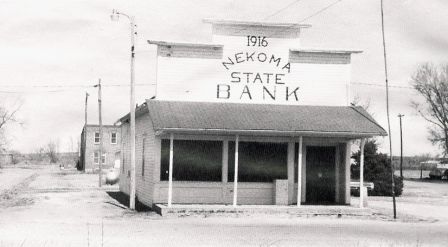 Over the years the bank endured many hardships but always seemed to emerge unscathed. A major snowstorm that struck Rush County on
March 23, 1957 left the town of Nekoma without telephone or electricity for almost six weeks. With no electricity, the bank could not operate its business machines. To keep the bank in operation, equipment was moved to Dr. Craven's office on west 8th Street in LaCrosse where employees took turns operating posting and recording machines every night.
Over the years the bank endured many hardships but always seemed to emerge unscathed. A major snowstorm that struck Rush County on
March 23, 1957 left the town of Nekoma without telephone or electricity for almost six weeks. With no electricity, the bank could not operate its business machines. To keep the bank in operation, equipment was moved to Dr. Craven's office on west 8th Street in LaCrosse where employees took turns operating posting and recording machines every night.
On November 29, 1963, burglars attempted to chisel their way into the back of the brick vault. Giving up after making a three inch hole in the back of the vault, the thieves climbed into the attic and set fire to a pile of debris on the vault ceiling before leaving empty-handed. The fire only smouldered and was discovered the next morning before causing serious damage. In January of the following year the burglars, two 18 year old boys, were arrested.
On July 30, 1969, burglars managed to gain access to the bank vault. Although causing considerable damage to the vault door and scattering the contents of several deposit boxes on the floor, they were unable to get to the money stored in the massive bullet safe. The thieves managed to make off with over $11,000 in travelers checks, but tossed the majority of the checks in a ditch near Timken. Authorities soon traced the remainder of the checks to New Orleans and Memphis. The following October, five suspects were apprehended by the FBI.
The mid 1980s was a particularly difficult era in the banking industry. In Rush County, five of the county's largest banks were closed over a 12 month period. The Nekoma bank stood strong throughout the crisis due to its conservative loan practices. “Bigger isn't always better,”" said bank President Loretta Moran in a 1991 interview with the Rush County News. “I was stingy with my money...I had to know you pretty good before I'd give you a loan.” It was during this period of uncertainty that Loretta first considered the possibility of selling the bank. What had become known as the last bank in Kansas to be operating in a wood frame building, would soon leave the tiny community that had been its home for 70 years.
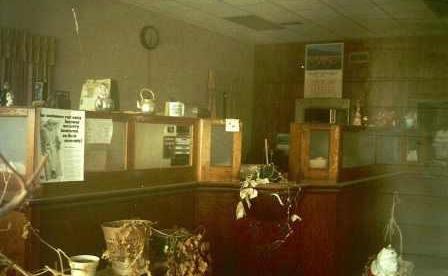 Relocating the bank was probably not a thought in the minds of the bank's owners as it continued to endure the economic ups and downs of the 1970s and 1980s. The Moran family remained involved in the bank throughout its 70-year history in Nekoma. In 1974, officers were children of two of the original directors.
Alice (Moran) Potter was chairman of the board, F.A. Moran was President, Loretta Moran was cashier, and Fern (Seaman) Ryan was assistant cashier.
Relocating the bank was probably not a thought in the minds of the bank's owners as it continued to endure the economic ups and downs of the 1970s and 1980s. The Moran family remained involved in the bank throughout its 70-year history in Nekoma. In 1974, officers were children of two of the original directors.
Alice (Moran) Potter was chairman of the board, F.A. Moran was President, Loretta Moran was cashier, and Fern (Seaman) Ryan was assistant cashier.
In February of 1986, following a rash of bank closures in Rush County, a group of investors approached the bank's directors with a proposal to relocate operations to LaCrosse in the former location of the Farmers and Merchants State Bank. March 13, 1987 was the last day of operations at the Nekoma location. The last depositor in the old bank was Teresa Moran, daughter of John P. Moran. On Tuesday, March 17, 1987, the Nekoma State Bank opened in LaCrosse. For a period of time, the Moran family continued to maintain an active role in the bank with Loretta Moran, daughter of M. T. Moran, serving as vice-president and William R. “Bill” Potter II, son of Alice Potter, serving as assistant vice-president.
The old building sat empty for the next several years, however, several of its original “tenants” remained behind. Patrons of the bank remember the dozens of live plants that nearly covered the front windows of the building. For several years, former employees continued to care for the plants providing an appearance of continued activity until eventually the foliage succumbed to the harsh environment and ravages of time. From that time, through the 1990s, the bank building remained almost in a state of suspended animation. Walking into the building in 2001, it was as if one was transported 15 years back in time. Books and papers rested on counters and desks as though they had been left yesterday. Furniture and equipment remained as it had been on that last Friday of business. Even the calendars on the walls displayed March 1987. The building was a veritable time capsule waiting to be reopened.
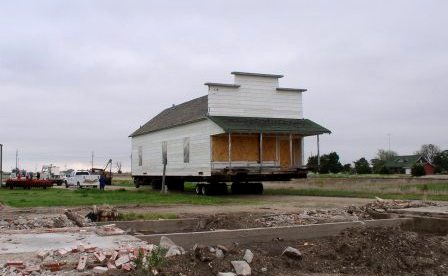 A Bank on Wheels may at first sound unusual, but in Rush County, the Nekoma Bank held that distinction for about 2 1/2 hours. For years, there had been discussions about moving the bank building to the museum complex in LaCrosse and restoring it as a banking museum. In 2002,
realizing that this would be the most logical way to preserve the threatened structure, the Moran family donated the bulding to the historical society. The family also agreed to loan the banking equipment as long the building continued to be used as a museum. Immediately, plans were set in motion as a myriad of arrangements were needed to be made for the 11 mile trip on back roads from Nekoma to LaCrosse.
A Bank on Wheels may at first sound unusual, but in Rush County, the Nekoma Bank held that distinction for about 2 1/2 hours. For years, there had been discussions about moving the bank building to the museum complex in LaCrosse and restoring it as a banking museum. In 2002,
realizing that this would be the most logical way to preserve the threatened structure, the Moran family donated the bulding to the historical society. The family also agreed to loan the banking equipment as long the building continued to be used as a museum. Immediately, plans were set in motion as a myriad of arrangements were needed to be made for the 11 mile trip on back roads from Nekoma to LaCrosse.
In October 2002, Alan Miller of AS.M Woodworks built a new foundation west of the Post Rock Museum in Grass Park. In December, Kuhn's House Moving in Victoria was contracted to move the building. Over the next few months, preparations began for the big move. The concrete and brick vault was dismantled. Over 55 boxes of memorabilia and bank souvenirs were placed in temporary storage along with much of the bank's equipment. In April, the building was ready to be moved.
According to the Rush County News, May 8, 2003, “Nekoma Bank was cut loose from its foundation, raised up, put on trucks, and was loaded and ready to travel by April 15. At 9 a.m. on Thursday, May 1, it was time to move. One cable line and seven power lines were lowered for the move, said Kay. The bank had to pass under 17 lines between the two locations. At 11:30 a.m., Nekoma Bank was at its new home.” (More pictures of the move)